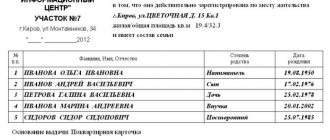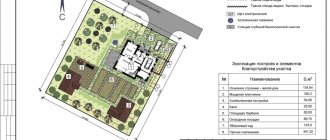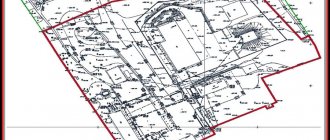An extract from the PZZ for a land plot may be required in different situations. Not all citizens know what this document is or what information it contains. Questions also arise about where and how to obtain such a certificate.
It is important to understand how the PZZ is deciphered, why and when an extract from such a document is needed, to whom it is issued, and by whom it is compiled. To answer these questions, it is worth familiarizing yourself with the provisions of the Town Planning Code of the Russian Federation.
PZZ - what kind of documents are these? Legislation
What is an on-load tap-changer and why is it needed?
PZZ what is being built, what is decoding? The concept of PPZ appeared in the country's legislation with the adoption of the Urban Planning Code (UGK RF). The first code articles reveal their concept.
According to the Town Planning Code of the Russian Federation, the Town Planning Zone (UPZ) is a town planning document. It establishes urban planning rules, territorial zones, the procedure for their application and changes.
In other words, this document divides all the land in the city into zones that will be used in a specific way.
These documents were developed and adopted by acts of the municipal authorities. Thus, these rules will be different for each commune, taking into account the specifics of the area, conditions and development plans of the area.
Therefore, general provisions on LDP are contained in the GPD of the Russian Federation. And the rules of a particular settlement must be approved by local authorities.
Why are PZZ needed?
The provisions of the State Scientific Center of the Russian Federation show that this document is very important and necessary. And Art. 30 of this Code clearly defines the purposes of its adoption.
They were adopted to ensure the conditions:
- planning and development of urban areas (other municipalities);
- attract investors for your development;
- protection of cultural heritage sites and the environment;
- protection of the legitimate interests of owners of capital buildings, land plots, as well as other individuals and legal entities.
The PZZ consists of several parts. This is both the plan itself and its descriptive part. It contains a real map (plan), on which the entire earth is divided into separate zones. For each of them, the rules of use, density and height of buildings are indicated.
In fact, this plan shows where and what kind of land is located, what its boundaries are, how it can be used, and what kind of development is allowed on it.
Why is this so important? Thanks to such plans, residential areas (zones) try not to be adjacent to industrial ones. And when developing empty plots, certain requirements are observed that do not allow arbitrary construction of buildings.
Failure to comply with these requirements, such as buildings that are too dense or tall, can create uncomfortable or even dangerous living conditions in the area.
What are the differences between the General Plan and the Land Use Plan?
General plans are classified by the State Scientific Center of the Russian Federation as documents for territorial planning of cities and towns. They contain maps that indicate the boundaries of the settlement, its division into zones, as well as the planned future location of various objects. This document also has a text part.
However, the Master Plan does not contain any urban planning regulations and therefore does not regulate permitted development.
This plan shows the functional zones of residential areas. In fact, it was created for the future, indicating the main directions of development of the territory of a particular city (estate).
On the other hand, PZZs reflect the current state of a given territory. They describe in more detail what, where and how it is located, what can be built and to what extent.
Their maps reflect in more detail the division of the territory into zones. In addition, the PZZ contains urban planning rules. In essence, this is an act of local self-government, approved by resolutions of the municipal authorities, published in the official media.
In case of discrepancy, they are subject to cancellation, they can be appealed in court
The Review of Judicial Practice of the Supreme Court contains one important point for city defenders. It should be noted that the review is not a statement of law, but it is a document reflecting the position of the Supreme Court on cases that the Presidium of the Supreme Court considered important and included in the review. In many cases, reference to decisions reflected in the review will be a very important signal to lower courts.
So, the Supreme Court indicated that the Land Use and Development Rules must comply with the master plan.
In a particular case, we were talking about a municipal entity, but this does not change the essence - we are talking about the fundamental principles of the Town Planning Code.
57. The rules for land use and development of a municipality must comply with the master plan of this municipality.
The prosecutor filed an administrative claim in court to declare invalid from the date of adoption of the rules of land use and development of the municipality in terms of establishing on the map urban zoning within the boundaries of a number of land plots of the territorial zone Zh2 (zone with low-rise buildings for seasonal residence) and within the boundaries of a number of other land plots territorial zone Zh1.1 (residential zone with low-rise residential buildings for permanent residence with limited or developed personal subsidiary plots).
In support of the stated requirements, he indicated that the contested legal regulation was carried out without taking into account the provisions of the master plan of the municipality, according to which the named land plots are located in the functional zone of specially protected environmental areas.
The administrative claim was satisfied by the decision of the court of first instance.
The Judicial Collegium for Administrative Cases of the Supreme Court of the Russian Federation upheld this decision of the first instance court for the following reasons.
Legislation on urban planning activities consists of the Urban Planning Code of the Russian Federation (hereinafter referred to as the RF Civil Code), other federal laws and other regulatory legal acts of the Russian Federation, as well as laws and other regulatory legal acts of the constituent entities of the Russian Federation. On issues of urban planning activities, municipal legal acts are adopted, which should not contradict the Urban Planning Code of the Russian Federation (Article 3 of the Civil Code of the Russian Federation).
In accordance with the provisions of Art. 2 of the Civil Code of the Russian Federation, legislation on urban planning activities and normative legal acts issued in accordance with it are based, inter alia, on the principles of ensuring integrated and sustainable development of the territory based on territorial planning, urban zoning and territory planning, balanced consideration of environmental, economic, social and other factors when carrying out urban planning activities, carrying out urban planning activities in compliance with the requirements for the preservation of cultural heritage sites and specially protected natural areas.
Sustainable development of territories is to ensure, when carrying out urban planning activities, safety and favorable conditions for human life, limiting the negative impact of economic and other activities on the environment and ensuring the protection and rational use of natural resources in the interests of present and future generations (clause 3 of article 1 of the Civil Code of the Russian Federation ).
In accordance with Part 1 of Art. 9 of the Civil Code of the Russian Federation, territorial planning is aimed at determining in territorial planning documents the purpose of territories based on a set of social, economic, environmental and other factors in order to ensure the sustainable development of territories, the development of engineering, transport and social infrastructure, ensuring that the interests of citizens and their associations, the Russian Federation are taken into account , constituent entities of the Russian Federation, municipalities.
By virtue of Part 3 of Art. 9 of the Civil Code of the Russian Federation, territorial planning documents are mandatory for state authorities and local governments when they make decisions and implement such decisions.
Thus, for the harmonious development of territories, the task of local governments when developing territorial planning documents is the need to ensure a fair balance between public interests and the rights of private individuals by harmonizing these rights and interests, including in the field of ensuring favorable living conditions.
Clause 2, Part 1, Art. 34 of the Civil Code of the Russian Federation stipulates that when preparing rules for land use and development, the boundaries of territorial zones are established, including taking into account functional zones and the parameters of their planned development, determined by the master plan of a rural settlement.
Thus, in accordance with the provisions of Part 3 of Art. 9, hh. 9 and 10 art. 31, clause 2, part 1, art. 34 of the Civil Code of the Russian Federation, the principle of compliance of land use and development rules with the master plan must be observed.
At the same time, the results of public hearings do not exclude the need to comply with the specified principle of compliance of land use and development rules with the master plan of a rural settlement as the fundamental document of territorial planning, a derivative of which is the requirement that territorial zones correspond to the functional zones defined by the master plan.
From the systemic interpretation of the provisions of paragraphs. 2, 5, 6, 7 and 8 tbsp. 1, part 15 art. 35 of the Civil Code of the Russian Federation it follows that the establishment of territorial zones specifies the provisions of territorial planning documents in order to determine the legal regime for the use of land plots, without changing the purpose of the territory classified as functional zones.
Taking into account the above, the contested legal regulation violates the requirements of urban planning legislation, since it was implemented without taking into account the provisions of the master plan of the municipality, according to which the above-mentioned land plots are located in the functional zone of specially protected environmental areas.
Link to the case itself: Determination No. 81-APG18-11
Thus, if suddenly the government tries to change the PZZ, and the change is such that it contradicts the General Plan, then such a change can be appealed.
PPZ or General Plan - what comes first?
What problems arise when developing principles of land management and development?
Zoning rules and the general plan are similar in content and include both land use plans and the text that describes them. Therefore, the question often arises, which document is the main and primary one.
It is logical and consistent to assume that plans for future spatial development (the Master Plan) are first adopted, and then the ZRP for their implementation is approved.
Actually.
The master plan should serve as the basis for the development of regulations. And even the State Scientific Center of the Russian Federation itself states that the prepared draft rules must be checked for compliance with the current General Plan.
However, this is not the case in all localities. And many master plans were developed a long time ago and do not at all correspond to today's needs.
Problems of development of PZZ
Therefore, two documents may even somewhat contradict each other. On the other hand, if a given city does not have a Master Plan, these principles can be used as a basis for preparing one. It is because of this confusion that what is primitive is still disputed.
The importance of adopting this document was discussed above. In addition, however, it should be noted that it is important not only to accept it, but also to draft it correctly. Incorrect wording of the provisions may cause certain difficulties for various subjects of land and other real estate ownership relations.
For example, they may affect the interests of various construction companies, which are the main developers in the housing sector. If the purpose of the site intended for construction changes, they incur significant losses. Adopting an IPM is not an easy process.
First, you need to develop a project. This work is entrusted to special committees. In this case, the decision on the preparation of the plan and the appointment of the commission must be made public.
Then the prepared project is submitted to the mayor (city president) for consideration. And he must decide to organize public hearings on this matter. Based on their results, projects can be submitted for approval or revision.
Given the path a project must take to get approved, acceptance often comes with many challenges.
The creation of a PZZ in the city may be hampered by the inconsistency of various officials and departments and dissatisfaction with the plan at public hearings. At the same time, this dissatisfaction is in many cases completely justified.
Organizations entrusted with the development of projects often make mistakes in them. Finding a good specialist for such work can be difficult.
Sometimes mistakes are caused not only by the level of professionalism, but also by the lack of urban planning documentation. In the absence of a master plan, working with established policies can be problematic.
Resolve issues with PZZ of the Moscow region and Moscow with RFI consult!
If you have any questions regarding urban zoning documents, you want to figure out whether you can change the type of permitted use of a land plot, you need to make changes to the PZZ in the Moscow region or Moscow, RFI consult lawyers will provide professional assistance.
We are confident that we can find an effective solution for each client, because we have lawyers with over 5 years of experience. RFI consult has been on the Moscow legal market since 1998 - and its enormous experience allows us to resolve even complex situations. Our regular clients are large developers in Moscow and the Moscow region.
Choose RFI consult to resolve issues with PPP in 2018 - evaluate our advantages:
- Minimum terms. We begin work on the case on the day the contract is signed, carefully develop a strategy for interaction with government agencies, and competently collect a package of documents. This allows you to obtain the necessary permits and achieve positive decisions from the first request.
- Trusting relationships with clients. We always describe prospects objectively, and if the chances of success are low, we offer clients alternatives. Our lawyers are ready to report on the progress of the case at any time. Trust highly qualified lawyers - and we will find the best way to implement your tasks.
- Affordable cost of services. We keep prices at a competitive level, so the cost of changing PZZ in the Moscow region or Moscow in 2021 is one of the lowest. Sign up for a consultation with a lawyer - and he will calculate it for your property, and also tell you how much time it will take us to solve your problem.
Who needs PZZ?
If it is adopted later, he may have to amend the RMP. Which in practice does not happen immediately. It is in such situations that inconsistencies in these documents often arise.
Why are land use and development rules needed?
Briefly answering this question, we can say that these rules apply to all people living in a given city.
After all, one of the goals of their adoption is to protect the human environment, natural and cultural objects, the rights of land users and other people living and working in a given territory.
If they did not exist, for example, industrial production would be located next to densely populated residential areas. And this will have a direct impact on their quality of life, safety and health.
By following the rules, the developer understands what buildings can be erected on specific sites. Thanks to this, he will be able to implement development projects and attract investors.
Through regulations, city authorities can regulate all issues related to the development and use of the territory of their settlement (city).
Download the rules of land use and development of the city of Moscow
Decree of the Moscow Government dated March 28, 2017 No. 120-PP “On approval of land use and development rules for the city of Moscow”
Book 1. General part and text materials of the territorial part of the Rules for land use and development of the city of Moscow
Book 2. Territorial part of the land use and development rules of the Central Administrative District
Book 3. Territorial part of the rules of land use and development of the Northern Administrative District
Book 4. Territorial part of the land use and development rules of the North-Eastern Administrative District
Book 5. Territorial part of the rules of land use and development of the Eastern Administrative District
Book 6. Territorial part of the land use and development rules of the South-Eastern Administrative District
Book 7. Territorial part of the rules of land use and development of the Southern Administrative District
Book 8. Territorial part of the land use and development rules of the South-Western Administrative District
Book 9. Territorial part of the rules of land use and development of the Western Administrative District
Book 10. Territorial part of the rules of land use and development of the North-Western Administrative District
Book 11. Territorial part of the rules of land use and development of the Zelenograd administrative district
Book 12. Territorial part of the rules of land use and development of the Novomoskovsk administrative district:
The territorial part of the rules of land use and development of the settlement of the Vnukovo territorial part of the rules for land use and development of the settlement of the Voskresensky territorial part of the rules for land use and development of the settlement of the Desennovskoye land use and development of the settlement of Kokoshkino territorial part of land use and development of the settlement of the Marushkinsky territorial part of the Landpolza rules the Moscow territorial part rules of land use and development of the settlement of Mosrentgen Territorial part of the rules of land use and development of the settlement of Ryazanovskoye Territorial part of the rules of land use and development of the settlement of Sosenskoye Territorial part of the rules of land use and development of the settlement of Filimonkovskoye
Book 13. Territorial part of the land use and development rules of the Trinity Administrative District:
Territorial part of the land use and development rules for the Voronovskoye settlement Territorial part of the land use and development rules for the Kievsky settlement Territorial part of the land use and development rules for the Klenovskoye settlement Territorial part of the land use and development rules for the Krasnopakhorskoye settlement Territorial part of the land use and development rules for the Mikhailovo-Yartsevskoye settlement Territorial part of the land use and development rules for the Novofe settlement Dorovskoe Territorial part of the land use and development rules for the settlement of Pervomaiskoye Territorial part of the land use and development rules for the Rogovskoye settlement Territorial part of the land use and development rules for the Shchapovskoye settlement










